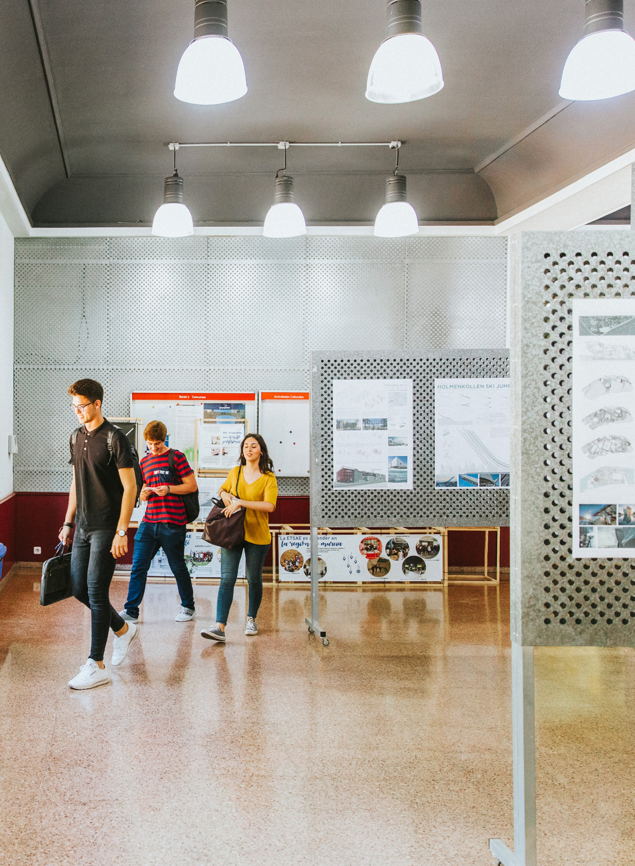
ETSAE
The School
The Higher Technical School of Architecture and Building Engineering (ETSAE), has its origin in the Technical Architecture studies that were taught since 2001 at the School of Civil Engineering. In 2008, the decision was made to implement Architecture studies, transform the title of Technical Architecture into Building Engineering, and create the Higher Technical School of Building Architecture and Engineering.

ETSAE is a young and dynamic institution, adapted to the real needs of the labor market, society, and its environment, with state-of-the-art software, equipment and technologies, exchange programs with more than 40 Erasmus destinations and other countries in South America and Asia. To do this, it has laboratories adapted to teaching and research, computer rooms, model workshops, etc.
The ETSAE offers the possibility of studying the Academic Program of Architecture (Degree in Fundamentals of Architecture + Master of Architecture) and the Degree in Building Engineering (Technical Architecture). These studies are completed with the official master's degrees in Building Science and Technology in Architecture and in Architectural Heritage.
Committed to quality teaching based on innovation, interdisciplinarity and internationalization, with numerous agreements with European and American Universities. The teacher / student ratio guarantees personalized teaching.
As for research, this center has numerous groups that work in the most cutting-edge and innovative lines.
HISTORY
The Superior Technical School of Architecture and Building has only 10 years at the UPCT.
For those who have participated in its creation, the hours of meetings and refinement remain of what was first called the special sensitivity that arose around the degree of Technical Architect within the University School of Civil Technical Engineering. But, above all, it was the convergence of this conviction with the rectoral strategy so that the UPCT had a school that would bring together all the studies related to building. Given that the degree of Technical Architect was already consolidated, the great challenge was to implement Architecture studies.
The first public step was the agreement signed by the Rector and the dean and president, respectively, of the Professional Colleges of Architects and Quantity Surveyors and Technical Architects of the Murcia Region. What happened on July 4, 2007, with great media coverage the following day.
The creation of a Joint Commission was derived from this agreement, which was chaired by the then vice-rector for institutional relations Antonio Viedma. This commission, after some functional adjustments, was in charge of writing the study plans for the degrees of Architect and Building Engineer. Works that culminated in the months of January and March, respectively, of 2008. The architecture study plan was immediately sent to ANECA, which informed it with a positive evaluation and sent it to the University Council. Once verified, the procedure of the Interuniversity Council in the Autonomous Community passed quickly, with which it was in a position to impart the new degree in the 2008-2009 academic year. Therefore, the constitution of the new center was urgent, which is carried out with all the favorable reports on July 16, 2008, ratifying the agreement of the Convergence and Quality Commission of June 6, 2008.
A few days before, the curriculum for the Graduate in Building Engineering had been sent to ANECA, since he had to wait for managerial activity to resume after the rector elections in May. Elections from which the idea of ¿¿the creation of the School of Architecture and Building Engineering was reinforced. ANECA reported the positive evaluation of the plan in December and the University Council verified them at its regular meeting on March 3, 2009.
The school was born with a number of students close to 1000, which makes it the second center of our university in number of students. This is a challenge for those responsible, given that all these events occur at the same time that the Spanish and world economy rode from the slowdown to the crisis, and from the crisis to the depression at high speed. So the school was born in times of difficulties and therefore will demand the greatest diligence and a sense of duty from those responsible.
In this short history of the School, mention cannot be made of the rationality and friendliness with which the segregation of the School of Civil Engineering took place, in which the degree in Technical Architecture, with all its teachers, had been since its introduction in the course. 2000-2001. Proper names of that process are those of Antonio García Martín, who chaired the commission that wrote the study plan. As well as Juan José Martínez García, José Calvo López, Vicente Ferrándiz Araujo, Josefina García León and Antonio Garrido Hernández and, of course, the rector of the Félix Faura Mateu University.

